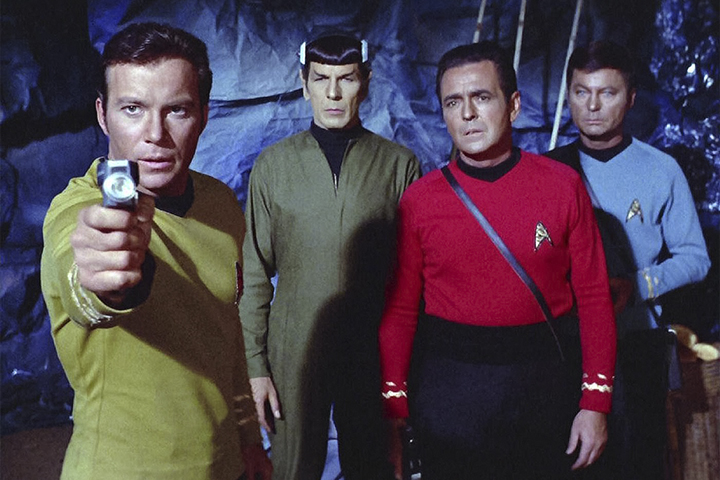
For the past half-century, across hundreds of TV episodes, multiple spinoffs, and more than a dozen movies, Star Trek has offered us a tantalizing glimpse of the future. Along the way, that’s included plenty of amazing technologies that have the potential to reshape life as we know it.
While much of it remains science fiction, a sizable number of the gadgets and tech toys that have appeared in Star Trek now exist, to some degree, in today’s world. Here are eight great examples.
Tractor beams
Star Trek’s tractor beam is an attenuated linear graviton beam which can be used by space stations or starships to control the movement of external objects — such as towing disabled ships to safety.
Researchers from the U.K.’s University of Bristol have developed and successfully demonstrated an acoustic tractor beam capable of trapping small objects in midair. In the near future, they hope tractor beams will be useful for moving things like kidney stones or eye floaters in the human body. Okay, so that’s not quite the same as trapping a Klingon starship, but it’s a good start!
Universal translators
We’re way ahead of the curve on this one! Star Trek claims that the universal translator, a device able to instantaneously translate between different languages, only comes into being late in the 22nd century.
Here in the 21st century, there are devices like Baidu’s pocket universal translator that’s able to easily translate spoken sentences from English into Mandarin and back again. Google has also developed in-ear translation earbuds for translating between numerous languages, and there are even apps capable of translating a baby’s cries into English.
Right now, the big difference between Star Trek’s technology and ours is the amount of time it takes to train these devices to understand new languages.
Phasers
Phased array pulsed energy projectiles, Star Trek’s phasers come in various different sizes, ranging from personal small arms to giant energy weapons capable of being mounted onto starships. They can also be used in a variety of ways, such as slicing through materials, heating objects, triggering explosions, or simply stunning an adversary.
In the current world, we’re still stuck using the phaser’s antecedent, the humble laser. On the plus side, laser projectiles are becoming more commonplace — including handheld laser cannons and Lockheed Martin’s modular ATHENA laser weapon, designed to shoot swarms of drones out of the sky.
Computers we can speak to
Allowing the crew in Star Trek to interact with computers by speaking to them solves one of the big screenwriting problems: making computer interactions both clear to the audience and interesting in a way that having everyone typing on keyboards simply wouldn’t be. Plus, nothing says “far future” quite like having your computer understand verbal commands, right?
Here in 2018, this is now so commonplace that we considered not even including it on this list. Almost all of our smartphones have A.I. assistants such as Apple’s Siri, while one of the fastest growing product categories is smart speakers like the Amazon Echo.
Hypospray
If you really, really hate needles then the existence of the “hypospray” would be enough to make Star Trek’s vision of the future sound like a utopia. Known colloquially as a “hypo,” this injection-free drug delivery system can inject liquids into the body at high speed without having to puncture the skin.
Today, an MIT spinoff called Portal is working on a next-generation needle-free jet injector, capable of injecting an ultra-fine stream of liquid — thinner than a strand of hair — through the skin at Mach 0.7. For those keeping track at home, that’s the cruising speed of an average commercial airliner. While it still involves piercing the skin, it’s a world away from the syringes in wide use today.
Tablet computer
Like computers which recognize your voice, this is one that always seems too obvious to mention nowadays. Nonetheless, within many of our lifetimes (certainly if you’re in your late twenties or older), we’ve watched computers slim down from bulky machines into flat, all-in-one devices no thicker than a pencil.
A person watching Star Trek: The Next Generation today may not realize how futuristic something like the crew’s Personal Access Data Devices (PADD) once appeared. But, trust us, it really was!
Food replicator
Unless you’re someone who simply loves the act of cooking, the idea of a Star Trek-style replicator, capable of materializing food and beverages sounds like a dream come true. Thanks to the wonders of modern science, it may not remain a dream for too much longer.
Food-based 3D printing is starting to hit its stride, while the National University of Singapore has developed a programmable cocktail glass, capable of tricking your senses into thinking that you’re drinking … well, just about anything you can imagine, really.
Warp drive
Aside from teleportation (which sadly isn’t a real thing just yet), warp speed is the most iconic Star Trek technology out there. It’s also the furthest away of any on this list — although it’s not impossible that we’ll get there.
In recent years, excitement has been building about NASA’s EmDrive technology, which could lead to ultrafast interplanetary travel. It’s not a “warp drive” per se, but should a real world demonstration actually happen, it’ll likely change our understanding of physics as we currently know it. But it’s also no longer a total fantasy, either.


